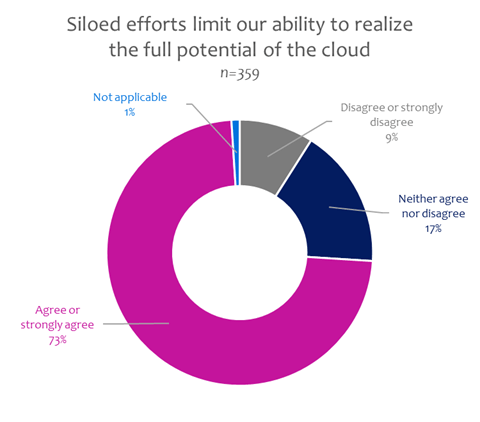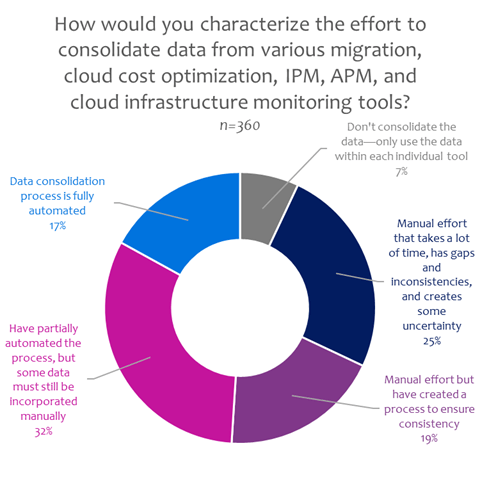Digital transformation, no matter what form it takes within your organization, is a high-stakes initiative to deliver strategic impact to the business. The cloud is a pivotal enabler to that effort. But there’s a flip side—challenges related to migrating and managing workloads in the cloud can have a negative impact on the success of your transformation efforts.
According to our recent State of Multi-Cloud Management survey, this is a very real problem that enterprises are struggling with. In fact, 73% of respondents stated that siloed efforts are limiting their ability to realize the full potential of the cloud. This means that three-quarters of digital transformation efforts are being sold short by an inability to capture maximum value from the cloud. That’s a lot of missed opportunity that could translate to lower-than-expected revenue, higher-than-expected costs, competitive backslides, and obstructed agility and innovation.

Why Siloed Cloud Data Is Such a Problem
Organizations have lots of tools—migration, cloud cost management, cloud cost optimization, IPM, APM, cloud infrastructure monitoring, and more—to monitor and manage different aspects of their complex multi-cloud environments. Each of these tools serves a particular need, solving one piece of the multi-cloud infrastructure puzzle and delivering visibility into its individual area of focus. The answer isn’t to consolidate all your tools down to just one or two that can do everything. Such a beast doesn’t exist. But you do want to consolidate the data from all the tools so that you can get a comprehensive and complete view of your multi-cloud infrastructure. Without that global visibility, you have an incomplete understanding of cost, performance, and risk.
The data consolidation effort, however, can be problematic. Only 17% of organizations surveyed said that the process is fully automated. More than three-quarters—76%—reported having to expend some level of manual effort. This creates a lot of extra work for teams that are already strapped. And 7% aren’t consolidating the data at all; they’re simply using each tool separately, keeping siloes firmly in place.

The Impact of Siloed Cloud Data
So, most organizations are manually consolidating data to some extent. It’s not a leap to imagine that this has an impact on how effective teams can be, but the numbers bear this out. We asked respondents to rate their ability to do the following:
- Automatically discover, map, tier, and monitor their infrastructure regardless of location
- Monitor and manage the performance of critical services and applications infrastructure anywhere within their distributed enterprise environments
- Manage the capacity of infrastructure elements and estates up and down the stack from on-premises storage and compute to multi-cloud resources
Overall, the majority of respondents (78-82%) said they somewhat or strongly agree they can do all of these things. When we break down the responses based on level of manual effort required to consolidate data from all their tools, however, it’s clear that the more effort it takes to fully and consistently “unsilo” the data, the harder it is to perform these important actions.
One-fifth of respondents who have fully automated data consolidation agree they can automatically discover, map, tier, and monitor infrastructure regardless of location, compared to only 7% who disagree. In contrast, 46% of the organizations performing the most manual and incomplete consolidation can’t accomplish this versus only 20% who say they can.

The numbers are similar when it comes to monitoring and managing performance of critical services. Of those who have fully automated data consolidation, 19% agree they can accomplish this and only 5% disagree. And 42% of respondents with highly manual data and spotty consolidation processes cannot perform this action compared to only 21% who can.

Likewise, 20% of those with high levels of data consolidation automation say they can manage the capacity of infrastructure elements and estates up and down the stack compared to 5% who cannot; 40% of the most manual and lest complete data consolidators cannot do this while only 24% can.

The takeaway here is that it’s not enough just to have data. After all, data is simply a means to better manage the multi-cloud environment that enables the ultimate digital transformation ends. For the data to facilitate your ability to understand, monitor, and manage a complex multi-cloud infrastructure, you need to be able to easily—i.e., with as little manual effort and as few gaps and inconsistencies as possible—combine it into a common data set. Only then can you improve your ability to realize the full value of the cloud.
Get More Value From Your Cloud Investment With Virtana Platform
Virtana Platform is a highly modular, scalable multi-cloud insights platform that provides unique performance, availability, capacity, and cost information to enable you to better manage your entire IT infrastructure. With Vitana Platform, you can achieve a complete end-to-end view of on-premises, private clouds, public clouds, and modern environments such as containers and serverless to understand your entire multi-cloud infrastructure. Try it for free
Get the survey report: The State of Multi-Cloud Management 2022Manage hybrid cloud performance, cost, and capacity: Try it for free

Heather Moore




